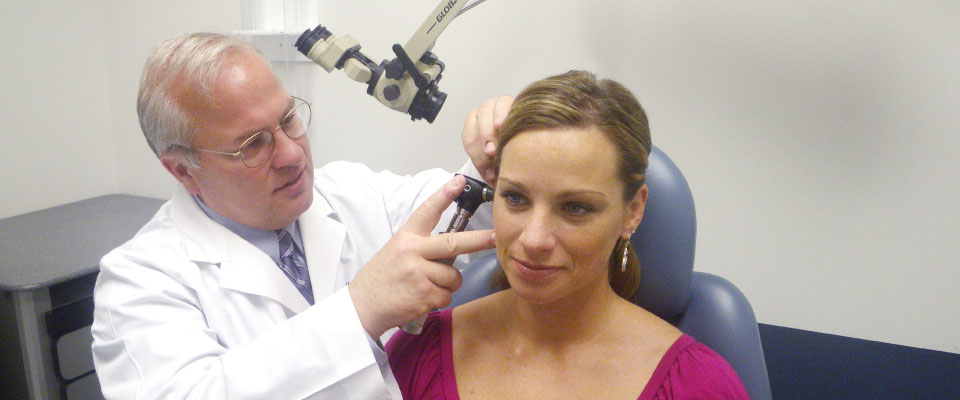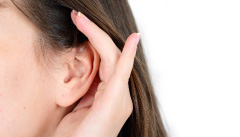Pediatric Sleep-disordered Breathing
Pediatric sleep-disordered breathing (SDB) is a general term for breathing difficulties occurring during sleep. SDB can range from frequent loud snoring to obstructive sleep apnea (OSA), a condition where part, or all, of the airway is blocked repeatedly during sleep. When a child’s breathing is disrupted during sleep, the body thinks the child is choking. The heart rate increases, blood pressure rises, the brain is aroused, and sleep is disrupted. Oxygen levels in the blood can also drop.
Approximately 10 percent of children snore regularly, and about two to four percent of children experience OSA. Recent studies indicate that mild SDB or snoring may cause many of the same problems as OSA in children.
What Are the Symptoms of Pediatric SDB?
Potential symptoms and consequences of untreated pediatric SDB may include:
- Snoring—The most obvious symptom of SDB is loud snoring that is present on most nights. The snoring can be interrupted by complete blockage of breathing, with gasping and snorting noises associated with waking up from sleep. Loud snoring can also become a significant social problem if a child shares a room with siblings, or at sleepovers and summer camp.
- Irritability—A child with SDB may become irritable, sleepy during the day, or have difficulty concentrating in school. He or she may also display busy or hyperactive behavior.
- Bedwetting—SDB can cause increased urine production at night, which may lead to bedwetting (also called enuresis).
- Learning difficulties—Children with SDB may become moody and disruptive, or not pay attention, both at home and at school. SDB can also be a contributing factor to attention deficit disorders in some children.
- Slow growth—Children with SDB may not produce enough growth hormone, resulting in abnormally slow growth and development.
- Cardiovascular difficulties—OSA can be associated with an increased risk of high blood pressure, or other heart and lung problems.
- Obesity—SDB may cause the body to have increased resistance to insulin, and daytime fatigue can lead to decreased physical activity. These factors can contribute to obesity.
What Causes Pediatric SDB?
A common physical cause of airway narrowing contributing to SDB is enlarged tonsils and adenoids. Overweight children are at increased risk for SDB because fat deposits around the neck and throat can also narrow the airway. Children with abnormalities involving the lower jaw or tongue, or neuromuscular deficits such as cerebral palsy, have a higher risk of developing SDB.
How is Sleep Apnea Diagnosed?
If you notice any of the symptoms described in this article, have your child checked by an ENT (ear, nose, and throat) specialist, or otolaryngologist. Sometimes physicians will make a diagnosis of SDB based on history and physical examination. In other cases, like children suspected of having severe OSA due to craniofacial syndromes, morbid obesity, neuromuscular disorders, or for children less than three-years-old, additional testing such as a sleep test may be recommended.
The sleep study, or polysomnography (PSG), is an objective test for SDB. Wires are attached to the head and body to monitor brain waves, muscle tension, eye movement, breathing, and the level of oxygen in the blood. The test is not painful and is generally performed in a sleep laboratory or hospital. Sleep tests occasionally produce inaccurate results, especially in children. Borderline or normal sleep test results may still result in a diagnosis of SDB based on parental observations and clinical evaluation.
What Are the Treatment Options?
Enlarged tonsils and adenoids are a common cause for SDB. Surgical removal of the tonsils and adenoids, called tonsillectomy and adenoidectomy (T&A), is generally considered the first line treatment for pediatric SDB if the symptoms are significant, and the tonsils and adenoids are enlarged. Of the more than 500,000 pediatric T&A procedures performed in the United States each year, the majority treat SDB. Many children with OSA show both short- and long-term improvement in their sleep and behavior after T&A.
Not every child with snoring needs to undergo T&A. If the SDB symptoms are mild or intermittent, academic performance and behavior is not an issue, the tonsils are small, or the child is near puberty (because tonsils and adenoids often shrink at puberty), it may be recommended that a child with SDB be watched conservatively and treated surgically only if symptoms worsen.
Recent studies have shown that some children have persistent SDB after T&A. A post-operative sleep study may be necessary, especially in children with persistent symptoms or increased risk factors for persistent apnea after T&A such as obesity, craniofacial anomalies or neuromuscular problems. Additional treatments such as weight loss, the use of continuous positive airway pressure (CPAP), or additional surgical procedures may sometimes be required.
What Questions Should I Ask My Doctor?
- Because tonsils and adenoids often shrink at puberty, how will I know it’s safe for my child if they are not removed?
- Is a sleep study required to make a diagnosis?
- After my child has had their tonsils and adenoids removed, will they have any problems with immune function?
Pediatric Sinusitis
Sinusitis (rhinosinusitis) in children can look different than sinusitis in adults. More often, children have a cough, bad breath, crankiness, low energy, and swelling around the eyes, along with a thick yellow-green nasal or post-nasal drip. Most of the time, children are diagnosed with viral sinusitis (or a viral upper respiratory infection) that will improve by just being treated for its symptoms, but antibiotics can be considered in severe cases of bacterial sinusitis.1 In the rare child where medical therapy fails, surgery can be used as a safe and effective method of treating sinus disease in children.
Your child’s sinuses are not fully developed until late in the teen years. Although small, the maxillary (behind the cheek) and ethmoid (between the eyes) sinuses are present at birth. Like sinusitis in adults, pediatric sinusitis can be difficult to diagnose because the symptoms may be caused by other problems, such as a viral illness or allergy.
What Are the Symptoms of Pediatric Sinusitis?
The following symptoms may indicate a sinus infection in your child:
- A cold lasting more than 10 to 14 days
- Low- or even high-grade fever
- Thick yellow-green nasal drainage for at least three days in a row
- Post-nasal drip, sometimes with sore throat, cough, bad breath, nausea and/or vomiting
- Headache, usually in children age six or older
- Irritability or fatigue
- Swelling around the eyes
What Causes Pediatric Sinusitis?
Young children are more prone to infections of the nose, sinus, and ears, especially in the first several years of life. Viruses, allergies, or bacteria usually cause sinusitis. Acute viral sinusitis is likely if your child has been sick for less than 10 days and is not getting worse. Acute bacterial sinusitis is likely when the sinusitis symptoms do not improve at all within 10 days of getting sick, or if your child gets worse within 10 days after beginning to get better.
Chronic sinusitis lasts 12 weeks or longer, and is usually caused by prolonged inflammation, instead of a long infection. Infection can be a part of chronic sinusitis, especially when it worsens from time to time, but is not usually the main cause.
What Are the Treatment Options?
If you take your child to an ENT (ear, nose, and throat) specialist, or otolaryngologist, they will examine your child’s ears, nose, and throat. A thorough history and examination usually leads to the correct diagnosis. The doctor may also look for factors that make your child more likely to get a sinus infection, including structural changes, allergies, and problems with the immune system.
Occasionally, special instruments will be used to look into the nose during the office visit. Imaging (X-rays) of the sinuses, such as a CT scan, are not recommended in acute sinusitis unless there are complications from the infection. Radiation safety concerns may limit imaging scans, especially in children younger than six-years-old.2
Acute Sinusitis—When bacterial sinusitis is present, most children respond very well to antibiotic therapy. Nasal steroid sprays or nasal saline (saltwater) drops or gentle sprays may also be prescribed for short-term relief of stuffiness. Over-the-counter decongestants and antihistamines are generally not effective for viral upper respiratory infections in children, and should not be given to children younger than two-years-old.
If your child has acute bacterial sinusitis, symptoms should improve within the first few days of treatment with antibiotics. Even if your child improves dramatically within the first week of treatment, it is important that you complete the antibiotic therapy. Your doctor may decide to treat your child with additional medicines if he/she has allergies or other conditions that make the sinus infection worse.
Chronic Sinusitis—If your child suffers from two or more symptoms of sinusitis for at least 12 weeks and has signs of sinus pressure, he or she may have chronic sinusitis.3 Chronic sinusitis or more than four to six episodes of acute sinusitis per year indicates that you should see an ENT specialist, who can recommend appropriate medical or surgical treatment.
Surgery may be considered for a small percentage of children with severe or persistent sinusitis symptoms despite medical therapy. In children under 13-years-old, your doctor may advise removing adenoid tissue4 from behind the nose as part of the treatment for sinusitis. Although the adenoid tissue does not directly block the sinuses, infection of the adenoid tissue, called adenoiditis (infection of the back of the nose that can cause blockage), can cause many symptoms similar to sinusitis—runny nose, stuffy nose, post-nasal drip, bad breath, cough, and headache.
In older children and those for whom medical therapy has been unsuccessful, adenoidectomy or other surgical options may be recommended. An ENT surgeon can open the natural drainage pathways of your child’s sinuses and make the narrow passages wider. This also allows for culturing the infection so that antibiotics can be directed specifically against the bacteria causing your child’s sinus infection. Opening the sinuses allows nasal medications to be distributed more effectively, allowing air to circulate and usually reducing the number and severity of sinus infections.
What Questions Should I Ask My Doctor?
- What is the most appropriate antibiotic to use to treat a sinus infection in my child?
- What are the complications from a sinus infection that I should be aware of for my child?
- How do you prevent sinusitis from occurring?
- Should I have my child tested for allergies?
1 Wald, ER, et al. “Clinical practice guideline for the diagnosis and management of acute bacterial sinusitis in children aged 1 to 18 years” Pediatrics. 2013;132(1):e261-80
2 Setzen G, Ferguson BJ, Han JK, et al., "Clinical consensus statement: appropriate use of computed tomography for paranasal sinus disease," Otolaryngol Head Neck Surg. 2012 Nov;147(5):808-16. doi: 10.1177/0194599812463848. Epub 2012 Oct 10.
3 Brietzke SE1, Shin JJ2, Choi S3, "Clinical consensus statement: pediatric chronic rhinosinusitis," Otolaryngol Head Neck Surg. 2014 Oct;151(4):542-53. doi: 10.1177/0194599814549302.
4 Brietzke SE et al. Clinical Consensus Statement: Pediatric Chronic Rhinosinusitis. Otolaryngol Head Neck Surg. 2014; 151(4).
Pediatric Hearing Loss
Three million children under the age of 18 have some kind of hearing loss. At birth, one in 1,000 children have significant permanent hearing loss. When mild hearing loss is included, six in 1,000 children are affected. By age 18, 17 in 1,000 people have some degree of permanent hearing loss (this does not include the type of hearing loss caused by fluid in the ears or ear infections).
What are the Symptoms of Pediatric Hearing Loss?
Some symptoms of pediatric hearing loss include:
- Speech and language delay
- Not babbling, or babbling has stopped
- By 12 months, does not understand simple phrases such as “wave bye-bye” or “clap hands”
- By two-years-old, should have 50 words and put two words together
- Not turning head in direction of sound
- Difficulties in school
What Causes Pediatric Hearing Loss?
Nerve hearing loss, also called sensorineural hearing loss (SNHL), is permanent. This is caused by genetic factors in half of cases. The other half of cases may be due to infection (such as meningitis or congenital cytomegalovirus, CMV), head trauma, noise trauma, anatomic abnormalities, or certain medications. Sometimes, a cause can’t be identified (idiopathic).
Conductive hearing loss is usually temporary and caused by fluid in the middle ear, or an abnormality of the eardrum or hearing bones. The middle ear is the part behind the eardrum where three tiny bones connect sound from the eardrum to the cochlea, the nerve part of the hearing. The middle ear is the area where ear infections occur. Ear infections can leave fluid in the middle ear after the infection is gone. On the other hand, some children can get fluid in the middle ear when the tube from the nose to the ear (the eustachian tube) does not work well.
Avoiding loud noises and head trauma will prevent hearing loss, and may prevent hearing loss from getting worse.
What Are the Treatment Options?
The earlier that hearing loss is diagnosed, the sooner appropriate treatment can be discussed and implemented to help your child hear and speak as well as possible. To make a diagnosis of hearing loss, different types of tests can be done depending on the age of the child. These include OAE (otoacoustic emission) test, ABR (auditory brainstem response) test, audiogram (standard hearing test), and tympanometry (checks eardrum function).
For temporary hearing loss, sometimes a simple visit to your doctor to remove earwax, perform an outpatient ear tube placement, or other medical treatment can correct the hearing loss.
For permanent hearing loss, hearing aids, bone anchored hearing aids, FM systems, and/or cochlear implants may be recommended depending on the type and severity of hearing loss. In addition to an ENT (ear, nose, and throat) specialist, or otolaryngologist, children with permanent hearing loss should be seen by other specialists, including an eye doctor (ophthalmologist) and in some cases, a heart doctor (cardiologist) and a genetics doctor. It is important to also consider speech therapy as soon as a diagnosis is made.
What Questions Should I Ask My Doctor?
- What can I do to make sure my child will have the best possible speech?
- Is my child’s hearing loss (or impairment) permanent or temporary?
- How can I prevent my child’s hearing from getting worse?
- How should I monitor my child’s hearing and speech?
- How important is it to read to my child?
- Do you recommend taking my child to see other specialists or therapists?
References
Grindle CR. Pediatric hearing loss. Pediatr Rev. 2014 Nov;35(11):456-63.
Otosclerosis
Otosclerosis describes a condition of abnormal bone growth around one of the three small bones in the middle ear space called the stapes. When bone around the stapes hardens, the bone cannot move freely, which limits the ability to properly transmit sound. This results in hearing loss; the less movement of the bone, the greater the degree of hearing loss.
Otosclerosis usually causes conductive hearing loss, which means there is a problem with how the ear transmits sound vibrations. In a normal ear, sound vibrations are funneled by the outer ear onto the ear drum, or “tympanic membrane.” The ear drum sends these vibrations to the small bones in the middle ear: the malleus (hammer), incus (anvil), and stapes (stirrup). When the stapes bone moves, fluid in the inner ear moves and stimulates hair cells in the inner ear. These cells turn sound vibrations into electrical signals that are sent to the brain. Hearing loss can occur if any part of this process is damaged.
What Are the Symptoms of Otosclerosis?
The symptoms of otosclerosis include:
- Progressive/worsening hearing loss
- Difficulty hearing low-pitched sounds or whispers
- Ringing, roaring, buzzing, or hissing in the ears or head, known as tinnitus
What Causes Otosclerosis?
An estimated 2.5 to 10 percent of adults have some otosclerosis in their middle ear. Hearing loss can happen anytime, but it often begins in young adults, those in their twenties or thirties. The condition can develop in both women and men, although it has a higher incidence in woman and has been linked to rapid onset during pregnancy. Otosclerosis affects both ears approximately 70 percent of the time, however, the amount of hearing loss may not be the same in each ear.
Approximately 60 percent of otosclerosis has an underlying genetic cause. Transmission of the gene that causes otosclerosis is complex and not everyone who has the gene will develop the condition.
Because many symptoms seen with otosclerosis can be caused by other medical or ear-related conditions, it’s important to be examined by an ENT (ear, nose, and throat) specialist, or otolaryngologist. After an examination, your ENT specialist may order a hearing test, or audiogram. A common finding is conductive hearing loss that is worse in low-frequency tones. Patients with otosclerosis can also have inner ear hearing loss, called sensorineural hearing loss.
The hearing test can also help determine if the stapes is not vibrating correctly, and your ENT specialist may request imaging scans of the ear. Based on the exam findings and test results, your doctor can make an accurate diagnosis and recommend treatment options that are best for you.
What Are the Treatment Options?
The main options for otosclerosis include observation with repeated hearing tests, a hearing aid(s), or surgery. Observation is recommended only for mild hearing loss. Some medicines such as sodium fluoride or bisphosphonate supplements have been reported to limit the worsening of otosclerosis, but there is no definitive evidence of preventing its progression.
Hearing aids can help overcome a fixed stapes by increasing the sound volume. Cost, style, fit, and possible benefits of a hearing aid should be discussed with your ENT specialist. In some states, a hearing aid trial may also allow you to sample a device prior to purchase. If a patient is prone to dizziness or has a diagnosis of Ménière’s disease, then trying a hearing aid before surgery may be advised.
Surgery for otosclerosis is called a stapedectomy or stapedotomy. In general, the stapes surgery is an outpatient procedure that can be done under local or general anesthesia. The surgery is done through the ear canal with an operating microscope, or endoscope. It involves removing part (stapedotomy) or all (stapedectomy) of the fixed stapes bone and replacing it with a prosthetic device or implant. The prosthetic device allows the bones of the middle ear to move again, correcting the conductive hearing loss. This surgery will not address any inner ear (sensorineural) hearing loss. The stapes prostheses are very small and will not set off metal detectors. Modern prostheses are also MRI compatible.
Pain is usually minimal but can vary. Some patients may experience dizziness the first few days after surgery. Taste sensation may also be altered for several weeks or months following surgery, but usually returns to normal. Risks of injuring the ear drum or causing additional hearing loss are rare but should be discussed. The ear canal is generally packed at the time of surgery to allow the ear drum to heal properly. Hearing improvement may not be noticed until it is removed. Discuss specific instructions on ear drops and other post-operative directions with your ENT specialist.
If otosclerosis affects both ears, typically the surgeon will choose to operate on the worst-hearing ear first and will not operate on both ears at the same time. The surgeon usually waits a minimum of six months before performing surgery on the second ear.
Following surgery, patients may be asked to refrain from nose blowing, swimming, or other activities that may get water in the operated ear or cause pressure within the middle ear space. Normal activities (including air travel) are usually resumed two to four weeks after surgery. Notify your ENT specialist immediately if any of the following occurs:
- Sudden hearing loss
- Intense pain
- Facial weakness
- Prolonged or intense dizziness, especially room-spinning sensation (vertigo)
- Any new symptom related to the operated ear
In advanced cases of otosclerosis, in which the disease has caused additional inner ear (sensorineural) hearing loss, a stapedectomy procedure may not be enough to restore useful hearing. In these situations, a cochlear implant may be considered.
What Questions Should I Ask My Doctor?
- Is my hearing loss conductive, sensorineural, or both?
- What are the pros and cons of using a hearing aid?
- Are hearing aids covered by insurance?
- What are the pros and cons, including the surgical risks, of undergoing stapes surgery?
- When could I expect my hearing to improve after surgery?
- If my hearing improves after surgery, would I still need a hearing aid?
- What if I do nothing?














